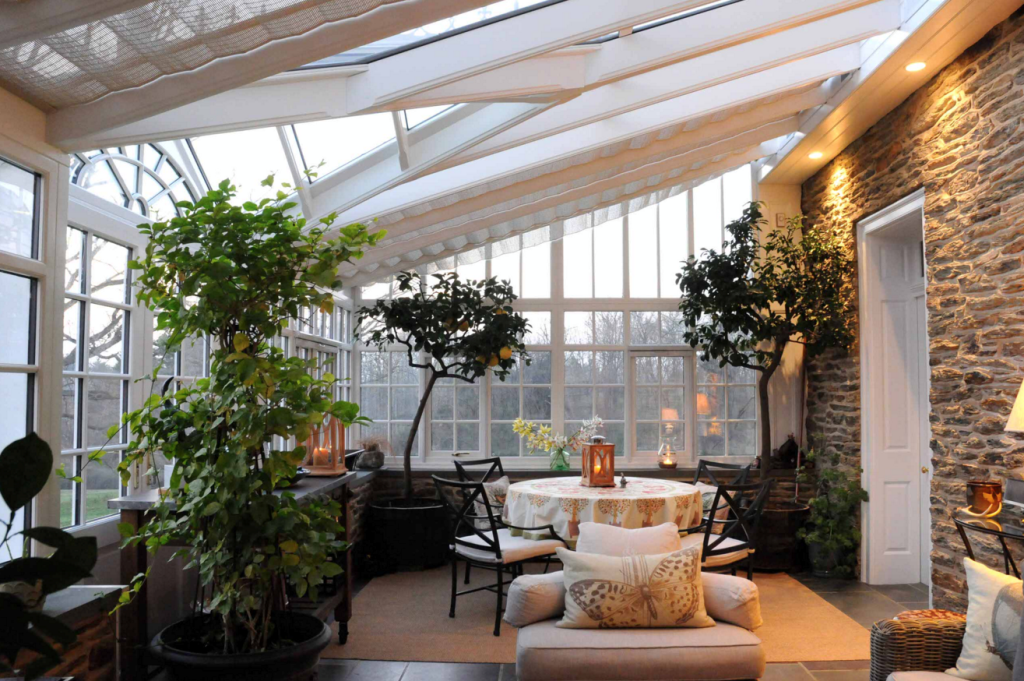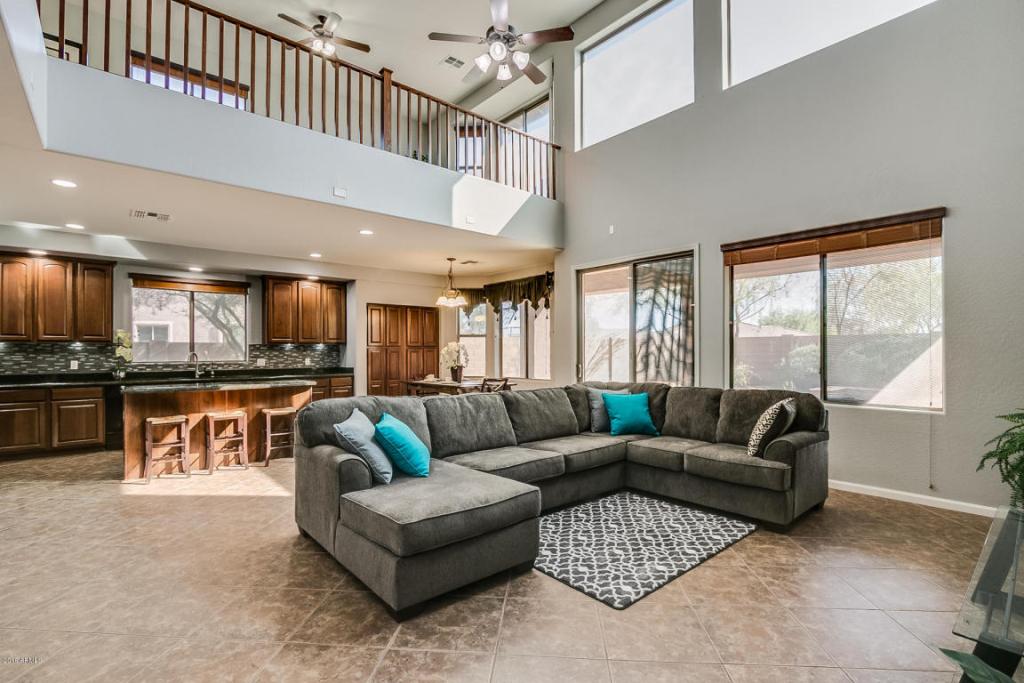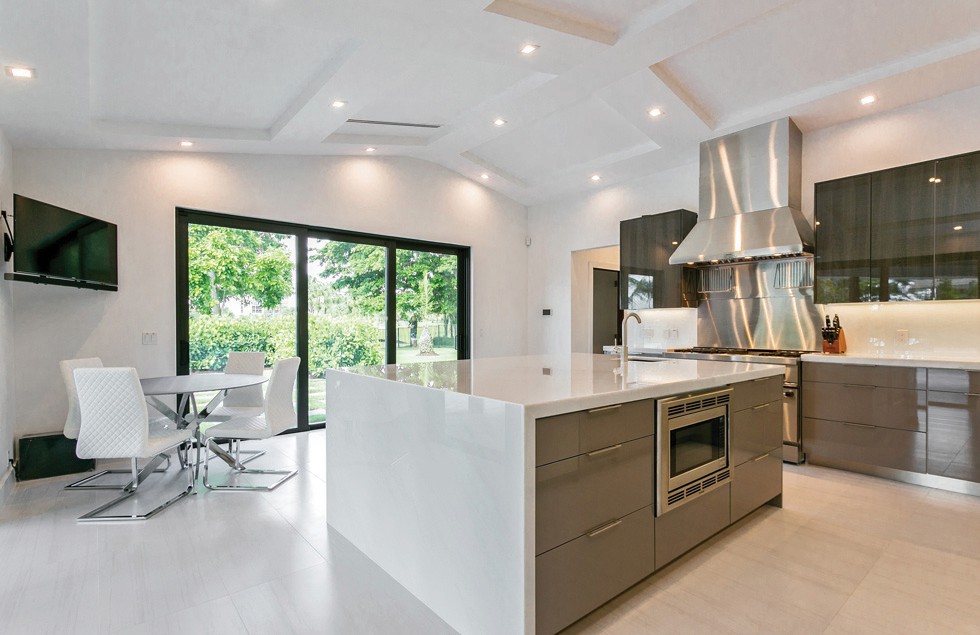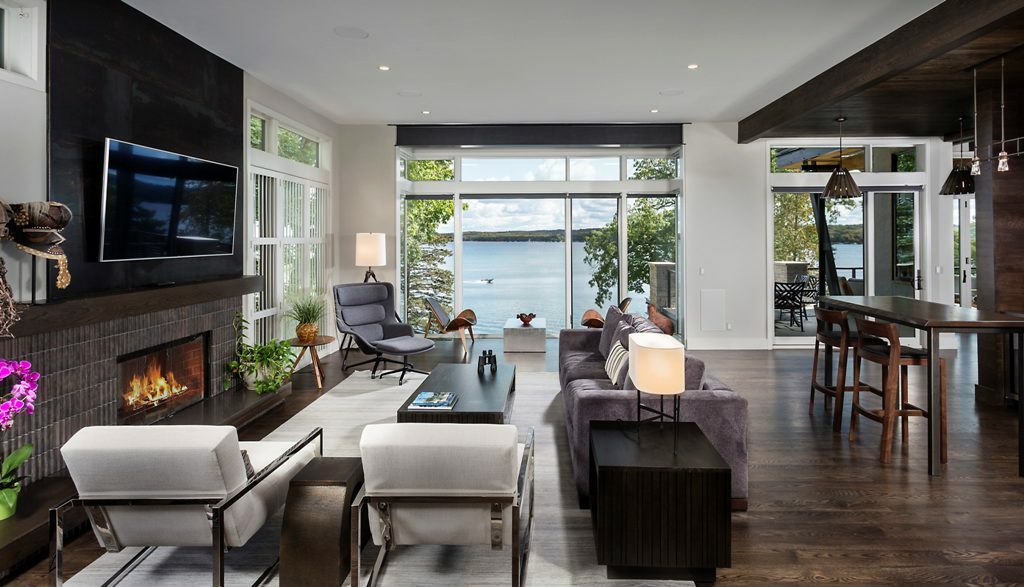If you’ve been paying attention to trends in the home design industry, you’ve probably noticed that newly built homes are beginning to look and function entirely different from the traditional houses that most of us saw growing up. Indeed, an unprecedented wave of human innovation is taking us into a very futuristic and advanced reality that’s starting to look a lot like something out of a science fiction movie. With the possibility of literal artificial intelligence (AI) and life-changing virtual reality (VR) and augmented reality (AR) on the rise, the devices found in smart homes are relatively simplistic in comparison to the grand scope of consumer technology available today. With that said, here are 18 future home design trends that are already starting to take root in mainstream residential construction, landscaping, and interior design:
1. Rooftop Solar Panels

California’s Bay Area provides a prime illustration of why the ubiquitous use of solar panels is practically inevitable. Even amidst the region’s current housing market crunch, the number of solar installations in the Bay Area is increasing substantially year after year, thanks partially to the state’s recently implemented requirement which mandates that all new homes built in California must be equipped with a solar system sufficient to accommodate the basic electricity needs of the residence. If you’re looking for a solar company in the Bay Area, Semper Solaris has been widely rated as one of the best solar companies in the region.
2. Indoor Greenery
Indoor plants are really starting to become far more commonplace than they were in previous decades, as the vast majority of design-conscious homeowners and interior decorators are moving along with the public trend towards gardening and horticulture in general. With numerous studies proving that house plants relieve stress, enrich air quality, and provide subliminal psychological comfort through the visual presence of lush greenery, many futuristic buildings are using indoor plants to create more inspirational living spaces and offices. If you are looking for tips on arranging your plants, you can find a comprehensive plant displays guide here.
3. Abundant Natural Lighting
Of course, plants and humans both need sunlight to thrive, and this fact is more well-known than ever before, with studies proving that more than half of the population is vitamin D deficient due to insufficient sun exposure. Letting sunlight in is also a matter of improving energy efficiency, as designers and builders are incorporating larger windows and skylights to completely illuminate indoor spaces without relying on artificial lighting.
4. Home Gyms and Exercise Equipment
Integrating fitness-related features into home construction and interior design is another increasingly common trend that will probably become commonplace in the newly built homes of the near future. Interior decorators are even using electric bicycles and other workout equipment as design pieces to add a bit of healthy personality to an otherwise empty spot. By 2030, those empty corners that people used to fill with armoires, shelves, and other generally useless storage spaces will be utilized more by exercise equipment and other functional components.
5. Built-In Storage Spaces

As mentioned above, the traditional approach to filing an empty space was to put some sort of storage piece such as a book shelf, clothing dresser, or an armoire for storing decorations and cookware. Within the next ten years, many newly built homes will begin to feature built-in storage spaces that let inhabitants get more out of their square footage without having to clutter up rooms with storage pieces. Examples of such spaces include under-the-stairs compartments, fold-out entertainment centers, and retractable in-wall drawers. Building storage space directly into various parts of the home is another norm that is likely in the next decade.
6. Smart Home Systems
The title “smart home” makes the topic seem more complicated and futuristic than it actually is. There are already plenty of smart homes popping up as people continue to adapt the technology, but in the near future, not having a smart home will be like not owning a smartphone. In case you’re completely out of the loop, a smart home is just a house that is equipped with all sorts of devices that can be remotely controlled to adjust and optimize various aspects of the home’s functionality and environment.
7. Minimalistic Living Rooms
Traditionally, living rooms have been places where families put a bunch of furniture and decorations to “make the home feel like a home.” However, modern interior design is moving from the old-fashioned approach of filling spaces with nostalgia and comfort and is moving more in the direction of creating expansive, airy, and minimalistic spaces. The average living room size is also increasing to allow for such open spaces while also providing room for a decent amount of furniture. Thus, the trade-off between having more furniture or more floor space is becoming less of an issue for homeowners and interior design specialists.
8. Glass Walls and Smart Glass
As mentioned earlier, natural sunlight is really in with architects and designers right now. As such, we’re seeing huge windows and glass walls becoming commonly requested features in new home construction. Likewise, “smart glass” – glass that allows you to adjust the tint and transparency of using a remote control – will also probably be a widespread norm by 2030.
9. Sun Rooms

The rise of sun room construction falls right in line with the general global trend towards eco-consciousness and self-sufficiency. An increasing number of homeowners understandably want access to the luxury of full sunlight combined with the comfort of an indoor environment. Plus, the use of instantly adjustable smart glass will make sun rooms an even more commonly requested design feature.
10. Lean-to Greenhouses
In alignment with the previous two trends, the continued rise of lean-to greenhouses will be fueled by a continually growing public interest in home gardening. Lean-to greenhouses are easy to assemble and add a very desirable function to a side of the home that would otherwise be serving no purpose whatsoever.
11. Offices, Home Theaters, and Game Rooms
If you were to look for homes built in the past two decades which include offices, home theaters, or game rooms, you’d find that only a small percentage of smaller home have these bonus areas. However, personal offices are becoming more necessary for the average homeowner due to the abundance of home business opportunities made available by the web. Likewise, with the unavoidable advent of active VR and AR will come an increased demand for designated game rooms and spacious home theaters where players can move around freely.
12. Advanced Security Systems
Over the next decade, the home design sector will see a notable increase in the use of advanced surveillance systems, alarms, motion sensors, PIN pads for entry, credential scanning, and other home security features. The average home will be equipped with remotely controllable cameras and integrated emergency response systems. On the higher end of the spectrum, more expensive properties will be outfitted with automated lock down systems that can immediately block off all entry points and windows with a single command.
13. Alternative Building Materials
The days of using wasteful materials and non-renewable resources seem to be almost behind us as a society, with many construction companies and designers opting instead for alternatives that are made from recycled or easily renewable sources. These materials provide a three-sided benefit in that they’re good for the environment, your health, and your building budget. Bamboo is one material in particular that will probably be seen in many more homes than it’s used in today. Other increasingly popular eco-conscious materials include Richlite (a composite wood-like material made from recycled paper) and hempcrete. These materials are quite popular in modular homes (learn more about those here) but are making their way into traditional properties as well.
14. Pristine and Spacious Living Areas

In the near future, less will be more when it comes to interior design. This change is due largely to the fact that consumers will crave more open areas to allow for better AR experiences. As active games and toys like large remote-control vehicle models and virtual sports games continue to become more widely used, larger stretches of free floor space will be desired by new homeowners. A few decades ago, in the design era of 1950-2010, materialism led to living spaces being filled to the brim with unnecessary items like night stands and coffee tables. In the near future, such clutter will be much less common.
15. Alternative Heating Systems
The typical hot air circulating heating systems seen in many homes today will be increasingly abandoned in favor of cleaner and more efficient alternatives. The rocket mass heater is one particularly innovative and unconventional design that many progressive builders and decorators are beginning to incorporate into their projects because it is arguably the cleanest and most efficient way to heat a home using conventional combustible fuel sources like wood. Of course, solar-powered heating systems are more ideal, but the rocket mass heater could wind up being the future’s version of today’s pollutive fireplaces and woodstoves. Other heating method like radiant floor heating will also be seen in a significant percentage of newly built homes.
16. Artificial Grass (Turf)
Did you know there’s a growing percentage of homeowners who are opting for artificial grass as part of a “no-mow” movement? That’s right, apparently people are finally starting to care about the amount of water used by sprinkler systems, fuel used by lawnmowers, and other resources and chemicals that are essentially wasted every year just to maintain our fluffy green lawns. Of course, the ongoing trends towards convenience will also convince more homeowners and designers to choose artificial grass since it requires virtually no maintenance. Sales projections from the artificial turf industry indicate that by 2030, you’ll be able to drive through just about any neighborhood and find yards that are almost entirely covered in AstroTurf.
17. Smart Lighting
In addition to using more efficient light bulbs all around, the average home will be equipped with smart lighting systems that can turn lights on/off and adjust the brightness and color of bulbs based on your set preferences. You’ll be able to set the system to turn off lights automatically when you leave the room and turn them back on when you return for automated energy savings. You’ll also be able to control any light in your home remotely via a central control panel, remote control, or smartphone app. Smart lighting technology is already widely available, but it will take another 5-10 years before it becomes the absolute norm.

18. Exotic and Eccentric Architecture
For the past couple of decades, the world has seen the extensive construction of cookie-cutter subdivisions and condominiums which most have similar shapes and floorplan configurations. In the near future, the average neighborhood will have a much wider variety of unique architectural styles and house shapes as the industry continues to trend towards bespoke design and alternative architecture. Smooth and free-flowing exteriors will begin to become just as common as the rigid corners and angles seen on today’s average home. Likewise, we’ll see an increased implementation of adjustable and movable structures such as interior walls that fold down.
Modern Home Design is Changing to Accommodate Technological Advancement
Ultimately, all of the design trends mentioned above are only growing in popularity for one reason – consumer demand. Construction companies and home designers are catering to the needs and requests of each client individually, so as society as a whole becomes more advanced, we’ll continue to see the adoption of more progressive and functional building and design techniques.
An example of one technology that could really change interior design more than any other invention would be AR. With the ability to augment the appearance of our living spaces simply by putting on a holographic headset, it is likely that many people will be opting for minimal furniture and neutral design themes, since you’ll be able to change aesthetics such as paint color or wall-mounted artwork just by adjusting the settings an in AR home design app.
Ultimately, all of these trends add up to a reality in which the average home will be more alive and customizable. Homeowners will find that their lives are much more comfortable and convenient, and families will be able to spend more time enjoying their homes, and less time taking care of it.






